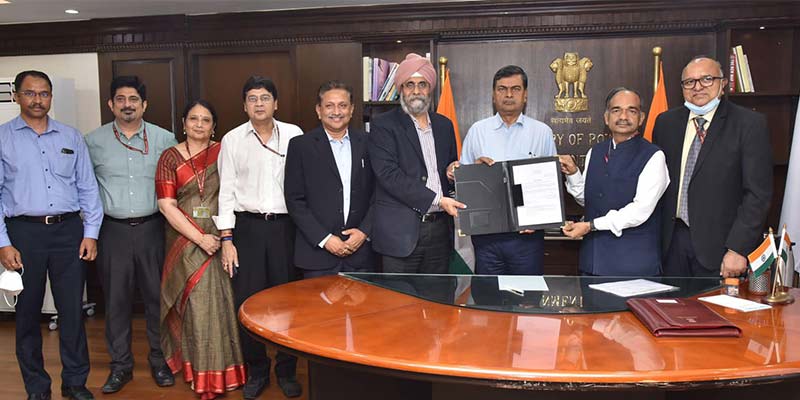- India
- Oct 13
What is Maharatna, Navratna and Miniratna status?
The government has accorded the ‘Maharatna’ status to state-owned Power Finance Corporation (PFC).
The move will pave the way for the company’s greater financial and operational efficiency.
An order to this effect was issued by the department of public enterprises, under the ministry of finance.
The grant of ‘Maharatna’ status to PFC will impart enhanced powers to PFC’s board while taking financial decisions.
Power Finance Corporation Limited (PFC)
• Power Finance Corporation Limited (PFC) was incorporated in 1986 with an objective to provide financial resources and encourage flow of investments to the power and associated sectors.
• It is a Central Public Sector Enterprise (CPSE) and a leading Non-Banking Financial Corporation (NBFC).
• PFC commenced its lending activity in 1988.
• PFC’s registered office is located at New Delhi and regional offices are located at Mumbai and Chennai.
• It is under the administrative control of the ministry of power.
• PFC was conferred the title of a ‘Navratna CPSE’ in June 2007.
• PFC group is the largest financial company in the Indian power sector.
• It is a Non-Banking Financial Company (NBFC) which provides innovative fund and non-fund based support for the overall development of the Indian power sector.
• PFC is the largest CPSE in terms of the balance sheet size. It is also the largest Infrastructure Finance Company (IFC) in India and largest government-owned NBFC.
• PFC has been a profit-making enterprise right since inception and has registered impressive growth in its net profit every year.
• By leveraging its expertise in financing the power sector and prudently deploying resources, PFC has evolved with the changing policy dynamics to emerge as a dominant market leader.
Functions of PFC
PFC plays a strategic role in the initiatives of the the Centre for the development of the power sector in India and works with central government agencies, state governments, power sector utilities, other power sector intermediaries and private sector clients for the development and implementation of policies and for structural and procedural reforms in the power sector in India.
PFC is actively involved in implementation of various flagship programmes for the power sector, including:
• Acting as the nodal agency for implementation of Ultra Mega Power Projects (UMPPs) and the Integrated Power Development Scheme (IPDS).
• Acting as a Bid Process Coordinator for the ‘Independent Transmission Projects’.
• Implementation partner of Capacity Building under Restructured Accelerated Power Development & Reforms Program (R-APDRP).
PFC offers a bouquet of fund-based and non-fund based products for its clientele in the power sector, including for generation (conventional and renewable), transmission and distribution projects as well as renovation and modernisation projects.
It has strategically expanded focus areas to include projects that represent forward and backward linkages to the core power sector projects, including procurement of capital equipment for the power sector, fuel sources for power generation projects and related infrastructure development as well as power trading initiatives.
PFC Consulting Ltd (PFCCL) was incorporated in March 2008 as a wholly owned subsidiary of Power Finance Corporation Limited to provide consultancy services to the power sector.
What is Maharatna, Navratna and Miniratna status?
Under Articles of Association, the board of directors of Central Public Sector Enterprises (CPSEs) enjoys autonomy in respect of recruitment, promotion and other service conditions of below board level employees.
The board of directors of a CPSE exercises delegated powers subject to broad policy guidelines issued by the government from time to time.
The government has granted enhanced powers to the Boards of the profit-making enterprises under various schemes like Maharatna, Navratna and Miniratna.
Maharatna scheme
• The main objective of the Maharatna scheme which was introduced in 2010 is to empower mega CPSEs to expand their operations and emerge as global giants.
• Maharatna CPSEs compared to others are given greater autonomy for flexibility in respect of capital expenditure, formation of strategic alliance, formulation of HR policies etc.
• The Board of a ‘Maharatna’ CPSE can make equity investments to undertake financial joint ventures and wholly-owned subsidiaries and undertake mergers and acquisitions in India and abroad, subject to a ceiling of 15 per cent of the networth of the concerned CPSE, limited to Rs 5,000 crore in one project.
• The board can also structure and implement schemes relating to personnel and human resource management and training. They can also enter into technology joint ventures or other strategic alliances.
Eligibility criteria for grant of Maharatna status
The CPSEs meeting the following eligibility criteria are considered for Maharatna status:
a) Having Navratna status.
b) Listed on Indian stock exchange with minimum prescribed public shareholding under SEBI regulations.
c) An average annual turnover of more than Rs 25,000 crore during the last three years.
d) An average annual net worth of more than Rs 15,000 crore during the last three years.
e) An average annual net profit after tax of more than Rs 5,000 crore during the last three years.
f) Should have significant global presence/international operations.
The Maharatna CPSEs are:
1) Bharat Heavy Electricals Limited
2) Bharat Petroleum Corporation Limited
3) Coal India Limited
4) GAIL India Limited
5) Hindustan Petroleum Corporation Limited
6) Indian Oil Corporation Limited
7) NTPC Limited
8) Oil & Natural Gas Corporation Limited
9) Power Grid Corporation of India Limited
10) Steel Authority of India Limited
11) Power Finance Corporation Limited (PFC).
Navratna scheme
The government introduced the Navratna scheme in 1997.
Under this scheme, the Boards of Navratna CPSEs have been delegated enhanced powers in the areas of:
i) Capital expenditure
ii) Investment in joint ventures/subsidiaries
iii) Mergers & acquisitions
iv) Human resources management, etc.
Eligibility criteria for grant of Navratna status
The CPSEs which are Miniratna I, Schedule ‘A’ and have obtained ‘excellent’ or ‘very good’ MOU rating in three of the last five years and have a ‘Composite Score’ of performance to be 60 or above in six identified performance parameters are eligible to be considered for grant of Navratna status.
The parameters are:
1) Net Profit to Net worth
2) Manpower Cost to total Cost of Production or Cost of Services
3) PBDIT to Capital employed
4) PBIT to Turnover
5) Earning Per Share
6) Inter Sectoral Performance
Navratna CPSEs are:
1) Bharat Electronics Limited
2) Container Corporation of India Limited
3) Engineers India Limited
4) Hindustan Aeronautics Limited
5) Mahanagar Telephone Nigam Limited
6) National Aluminium Company Limited
7) National Buildings Construction Corporation Limited
8) Neyveli Lignite Corporation Limited
9) NMDC Limited
10) Oil India Limited
11) Rashtriya Ispat Nigam Limited
12) Rural Electrification Corporation Limited
13) Shipping Corporation of India Limited.
Miniratna scheme
In October 1997, the government decided to grant enhanced autonomy and delegation of financial powers to some other profit making companies subject to certain eligibility conditions and guidelines to make them efficient and competitive.
These companies, called Miniratnas, are in two categories, namely, Category- I and Category-II.
Category-I CPSEs should have made profit in the last three years continuously, the pre-tax profit should have been Rs 30 crore or more in at least one of the three years and should have a positive net worth.
Category-II CPSEs should have made profit for the last three years continuously and should have a positive net worth.
Presently, there are 72 Miniratna CPSEs (60 Category-I and 12 Category-II).
Manorama Yearbook app is now available on Google Play Store and iOS App Store


